A Novel Magnetic β-Cyclodextrin-Modified Graphene Oxide and Chitosan Composite as an Adsorbent for Trace Extraction of Four Bisphenol Pollutants from Environmental Water Samples and Food Samples
Abstract
:1. Introduction
2. Results and Discussion
2.1. Characterization
2.2. Optimization of MSPE
2.2.1. Optimization of Adsorbent Amount
2.2.2. Optimization of Sample pH
2.2.3. Optimization of the Eluent
2.2.4. Optimization of Extraction Speed, Extraction Time, and Extraction Temperature
2.2.5. Optimization of Ion Type and Ionic Strength
2.2.6. Optimization of Elution Volume, Elution Speed, Elution Time, and Elution Temperature
2.2.7. Selection of Sample Volume
2.3. Interference Test
2.3.1. Effect of Humic Acid on Extraction Efficiency
2.3.2. Effect of Sugars on Extraction Efficiency
2.4. Method Validation
2.5. Recycling Experiment
2.6. Analysis of Real Samples
2.7. Comparison of Methods and Adsorption Mechanism
3. Materials and Methods
3.1. Reagents and Apparatus
3.2. Synthesis of MNCGC
3.2.1. Synthesis of Silica-Coated Fe3O4
3.2.2. Synthesis of MNCGC
3.3. MSPE Procedure
3.4. HPLC Analysis
4. Conclusions
Author Contributions
Funding
Institutional Review Board Statement
Informed Consent Statement
Data Availability Statement
Conflicts of Interest
References
- Colborn, T.; vom Saal, F.S.; Soto, A.M. Developmental effects of endocrine-disrupting chemicals in wildlife and humans. Environ. Health Perspect. 1993, 101, 378–384. [Google Scholar] [CrossRef]
- Sofen, L.E.; Furst, A.L. Perspective—Electrochemical sensors to monitor endocrine disrupting pollutants. J. Electrochem. Soc. 2019, 167, 037524. [Google Scholar] [CrossRef]
- Dhanjai; Sinha, A.; Wu, L.; Lu, X.; Chen, J.; Jain, R. Advances in sensing and biosensing of bisphenols: A review. Anal. Chim. Acta 2018, 998, 1–27. [Google Scholar] [CrossRef] [PubMed]
- Yin, H.; Zhou, Y.; Cui, L.; Liu, X.; Ai, S.; Zhu, L. Electrochemical oxidation behavior of bisphenol A at surfactant/layered double hydroxide modified glassy carbon electrode and its determination. J. Solid State Electrochem. 2011, 15, 167–173. [Google Scholar] [CrossRef]
- Michałowicz, J. Bisphenol A—Sources, toxicity and biotransformation. Environ. Toxicol. Pharmacol. 2014, 37, 738–758. [Google Scholar] [CrossRef] [PubMed]
- Liang, X.; Yin, N.; Liang, S.; Yang, R.; Liu, S.; Lu, Y.; Jiang, L.; Zhou, Q.; Jiang, G.; Faiola, F. Bisphenol A and several derivatives exert neural toxicity in human neuron-like cells by decreasing neurite length. Food Chem. Toxicol. 2020, 135, 111015. [Google Scholar] [CrossRef] [PubMed]
- Kim, J.J.; Kumar, S.; Kumar, V.; Lee, Y.M.; Kim, Y.S.; Kumar, V. Bisphenols as a legacy pollutant, and their effects on organ vulnerability. Int. J. Environ. Res. Public Health 2019, 17, 112. [Google Scholar] [CrossRef] [PubMed]
- Santoro, A.; Chianese, R.; Troisi, J.; Richards, S.; Nori, S.L.; Fasano, S.; Guida, M.; Plunk, E.; Viggiano, A.; Pierantoni, R.; et al. Neuro-toxic and reproductive effects of BPA. Curr. Neuropharmacol. 2019, 17, 1109–1132. [Google Scholar] [CrossRef] [PubMed]
- Liu, B.; Lehmler, H.J.; Sun, Y.; Xu, G.; Liu, Y.; Zong, G.; Sun, Q.; Hu, F.B.; Wallace, R.B.; Bao, W. Bisphenol A substitutes and obesity in US adults: Analysis of a population-based, cross-sectional study. Lancet Planet. Health 2017, 1, e114–e122. [Google Scholar] [CrossRef]
- Chin, K.Y.; Pang, K.L.; Mark-Lee, W.F. A review on the effects of bisphenol A and its derivatives on skeletal health. Int. J. Med. Sci. 2018, 15, 1043–1050. [Google Scholar] [CrossRef]
- Catenza, C.J.; Farooq, A.; Shubear, N.S.; Donkor, K.K. A targeted review on fate, occurrence, risk and health implications of bisphenol analogues. Chemosphere 2020, 268, 129273. [Google Scholar] [CrossRef]
- Liu, D.; Liu, J.; Guo, M.; Xu, H.; Zhang, S.; Shi, L.; Yao, C. Occurrence, distribution, and risk assessment of alkylphenols, bisphenol A, and tetrabromobisphenol A in surface water, suspended particulate matter, and sediment in Taihu Lake and its tributaries. Mar. Pollut. Bull. 2016, 112, 142–150. [Google Scholar] [CrossRef]
- Liu, A.F.; Qu, G.B.; Yu, M.; Liu, Y.W.; Shi, J.B.; Jiang, G.B. Tetrabromobisphenol-A/S and nine novel analogs in biological samples from the Chinese Bohai Sea: Implications for trophic transfer. Environ. Sci. Technol. 2016, 50, 4203–4211. [Google Scholar] [CrossRef]
- Song, S.; Ruan, T.; Wang, T.; Liu, R.; Jiang, G. Distribution and preliminary exposure assessment of bisphenol AF (BPAF) in various environmental matrices around a manufacturing plant in China. Environ. Sci. Technol. 2012, 46, 13136–13143. [Google Scholar] [CrossRef] [PubMed]
- Liu, J.; Zhang, L.; Lu, G.; Jiang, R.; Yan, Z.; Li, Y. Occurrence, toxicity and ecological risk of Bisphenol A analogues in aquatic environment—A review. Ecotoxicol. Environ. Saf. 2021, 208, 111481. [Google Scholar] [CrossRef]
- Lee, S.; Liao, C.; Song, G.J.; Ra, K.; Kannan, K.; Moon, H.B. Emission of bisphenol analogues including bisphenol A and bisphenol F from wastewater treatment plants in Korea. Chemosphere 2015, 119, 1000–1006. [Google Scholar] [CrossRef] [PubMed]
- Zhang, H.; Zhang, Y.; Li, J.; Yang, M. Occurrence and exposure assessment of bisphenol analogues in source water and drinking water in China. Sci. Total Environ. 2019, 655, 607–613. [Google Scholar] [CrossRef]
- Wang, H.; Liu, Z.H.; Tang, Z.; Zhang, J.; Yin, H.; Dang, Z.; Wu, P.X.; Liu, Y. Bisphenol analogues in Chinese bottled water: Quantification and potential risk analysis. Sci. Total Environ. 2020, 713, 136583. [Google Scholar] [CrossRef] [PubMed]
- Huang, C.; Wu, L.H.; Liu, G.Q.; Shi, L.; Guo, Y. Occurrence and ecological risk assessment of eight endocrine-disrupting chemicals in urban river water and sediments of South China. Arch. Environ. Contam. Toxicol. 2018, 75, 224–235. [Google Scholar] [CrossRef]
- Chen, X.W.; Zhao, J.L.; Liu, Y.S.; Jiang, Y.X.; Yang, Y.Y. Occurrence and ecological risks of hormonal activities in the middle and lower reaches of Yangtze River. Asian J. Ecotoxicol. 2016, 11, 191–203. [Google Scholar]
- Chen, D.; Kannan, K.; Tan, H.; Zheng, Z.; Feng, Y.L.; Wu, Y.; Widelka, M. Bisphenol analogues other than BPA: Environmental occurrence, human exposure, and toxicity—A review. Environ. Sci. Technol. 2016, 50, 5438–5453. [Google Scholar] [CrossRef]
- Cao, P.; Zhong, H.N.; Qiu, K.; Li, D.; Wu, G.; Sui, H.X.; Song, Y. Exposure to bisphenol A and its substitutes, bisphenol F and bisphenol S from canned foods and beverages on Chinese market. Food Control 2021, 120, 107502. [Google Scholar] [CrossRef]
- Lian, L.; Lv, J.; Wang, X.; Lou, D. Magnetic solid–phase extraction of tetracyclines using ferrous oxide coated magnetic silica microspheres from water samples. J. Chromatogr. A 2018, 1534, 1–9. [Google Scholar] [CrossRef]
- De Souza, K.C.; Andrade, G.F.; Vasconcelos, I.; de Oliveira Viana, I.M.; Fernandes, C.; de Sousa, E.M.B. Magnetic solid-phase extraction based on mesoporous silica-coated magnetic nanoparticles for analysis of oral antidiabetic drugs in human plasma. Mater. Sci. Eng. C 2014, 40, 275–280. [Google Scholar] [CrossRef] [PubMed]
- Chen, L.; He, Y.; Lei, Z.; Gao, C.; Xie, Q.; Tong, P.; Lin, Z. Preparation of core-shell structured magnetic covalent organic framework nanocomposites for magnetic solid-phase extraction of bisphenols from human serum sample. Talanta 2018, 181, 296–304. [Google Scholar] [CrossRef] [PubMed]
- Wu, Y.; Chen, C.; Zhou, Q.; Li, Q.X.; Yuan, Y.; Tong, Y.; Wang, H.; Zhou, X.; Sun, Y.; Sheng, X. Polyamidoamine dendrimer decorated nanoparticles as an adsorbent for magnetic solid-phase extraction of tetrabromobisphenol A and 4-nonylphenol from environmental water samples. J. Colloid Interface Sci. 2019, 539, 361–369. [Google Scholar] [CrossRef] [PubMed]
- Giannakas, A.; Patsaoura, A.; Barkoula, N.M.; Ladavos, A. A novel solution blending method for using olive oil and corn oil as plasticizers in chitosan based organoclay nanocomposites. Carbohydr. Polym. 2017, 157, 550–557. [Google Scholar] [CrossRef] [PubMed]
- Wang, J.; Zhang, J.; Han, L.; Wang, J.; Zhu, L.; Zeng, H. Graphene-based materials for adsorptive removal of pollutants from water and underlying interaction mechanism. Adv. Colloid Interface Sci. 2021, 289, 102360. [Google Scholar] [CrossRef] [PubMed]
- Wang, Z.; Zhang, P.; Hu, F.; Zhao, Y.; Zhu, L. A crosslinked β-cyclodextrin polymer used for rapid removal of a broad-spectrum of organic micropollutants from water. Carbohydr. Polym. 2017, 177, 224–231. [Google Scholar] [CrossRef] [PubMed]
- Araj, S.K.; Szeleszczuk, Ł. A Review on Cyclodextrins/Estrogens Inclusion Complexes. Int. J. Mol. Sci. 2023, 24, 8780. [Google Scholar] [CrossRef]
- Yamaura, M.; Camilo, R.L.; Sampaio, L.C.; Macêdo, M.A.; Nakamura, M.; Toma, H.E. Preparation and characterization of (3-aminopropyl)triethoxysilane-coated magnetite nanoparticles. J. Magn. Magn. Mater. 2004, 279, 210–217. [Google Scholar] [CrossRef]
- Dong, A.; Lan, S.; Huang, J.; Wang, T.; Zhao, T.; Xiao, L.; Wang, W.; Zheng, X.; Liu, F.; Gao, G.; et al. Modifying Fe3O4-functionalized nanoparticles with N-halamine and their magnetic/antibacterial properties. ACS Appl. Mater. Interfaces 2011, 3, 4228–4235. [Google Scholar] [CrossRef] [PubMed]
- Yang, K.; Xing, B. Adsorption of organic compounds by carbon nanomaterials in aqueous phase: Polanyi theory and its application. Chem. Rev. 2010, 110, 5989–6008. [Google Scholar] [CrossRef] [PubMed]
- Yang, D.; Li, X.; Meng, D.; Yang, Y. Carbon quantum dots-modified ferrofluid for dispersive solid-phase extraction of phenolic compounds in water and milk samples. J. Mol. Liq. 2018, 261, 155–161. [Google Scholar] [CrossRef]
- Zhang, Z.; Zhang, J.; Wang, Y.; Tong, Y.; Zhang, L. Controlled synthesis of hollow porous carbon spheres for enrichment and simultaneous determination of nine bisphenols from real samples. Talanta 2017, 167, 428–435. [Google Scholar] [CrossRef]
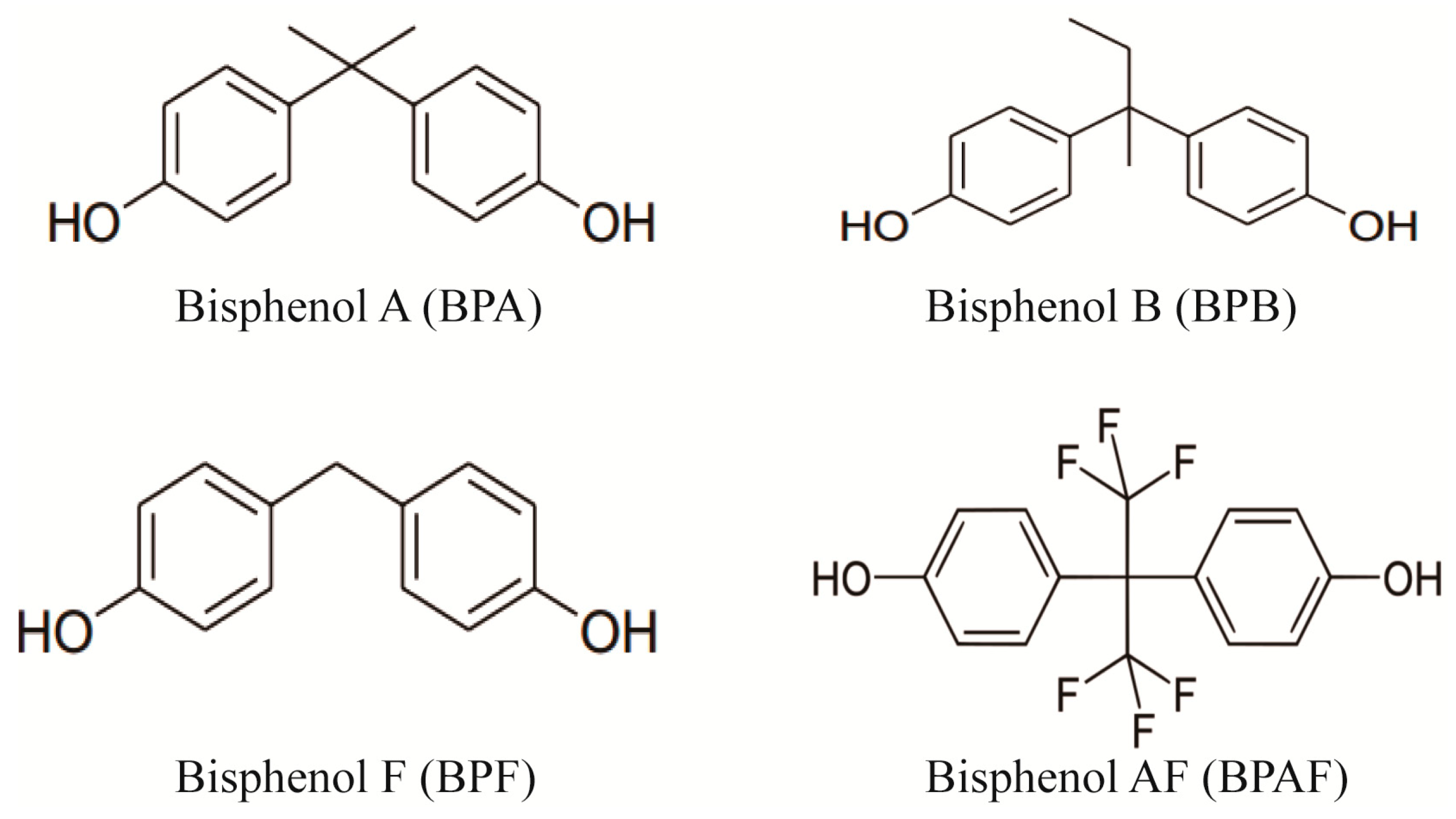

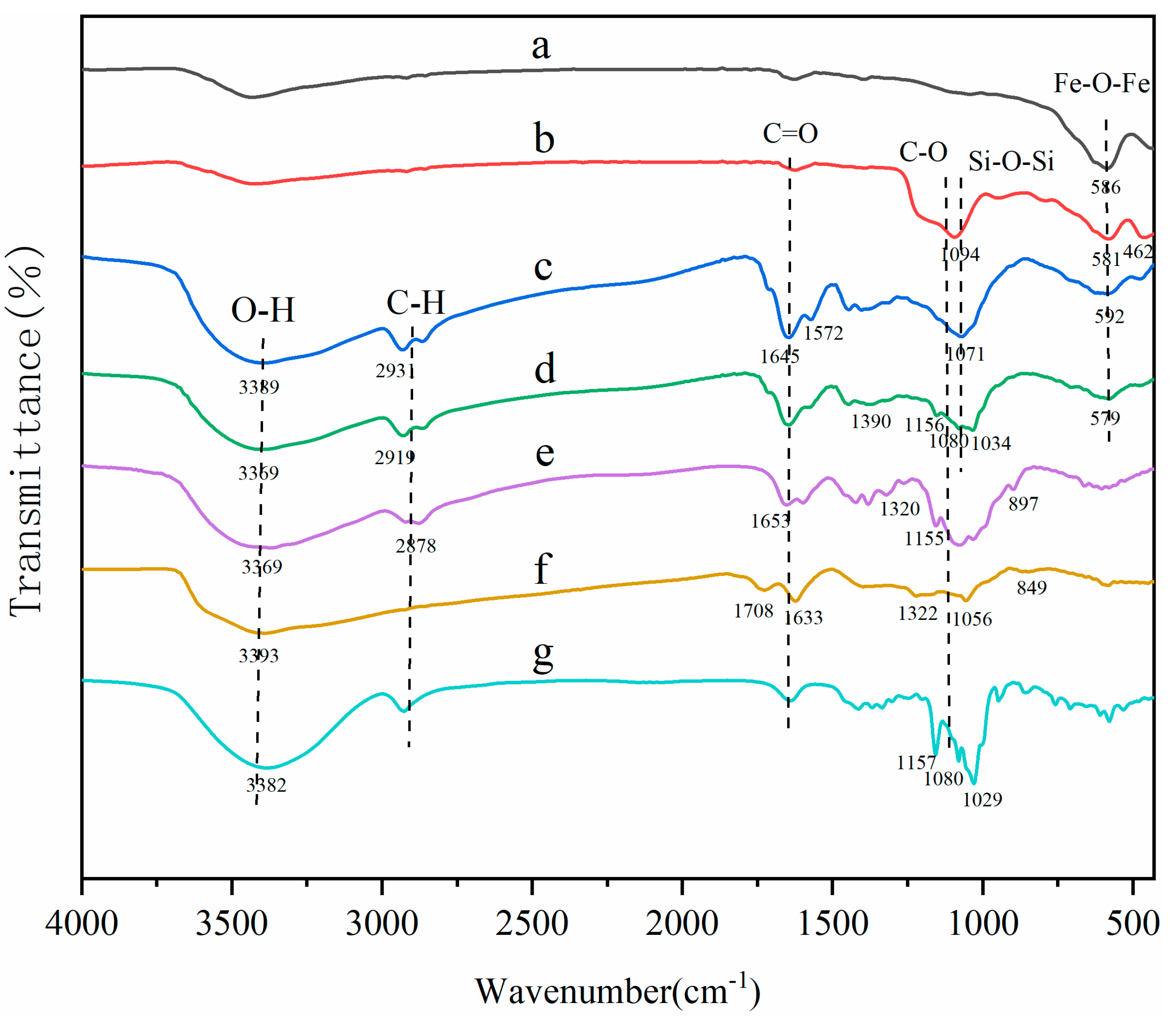

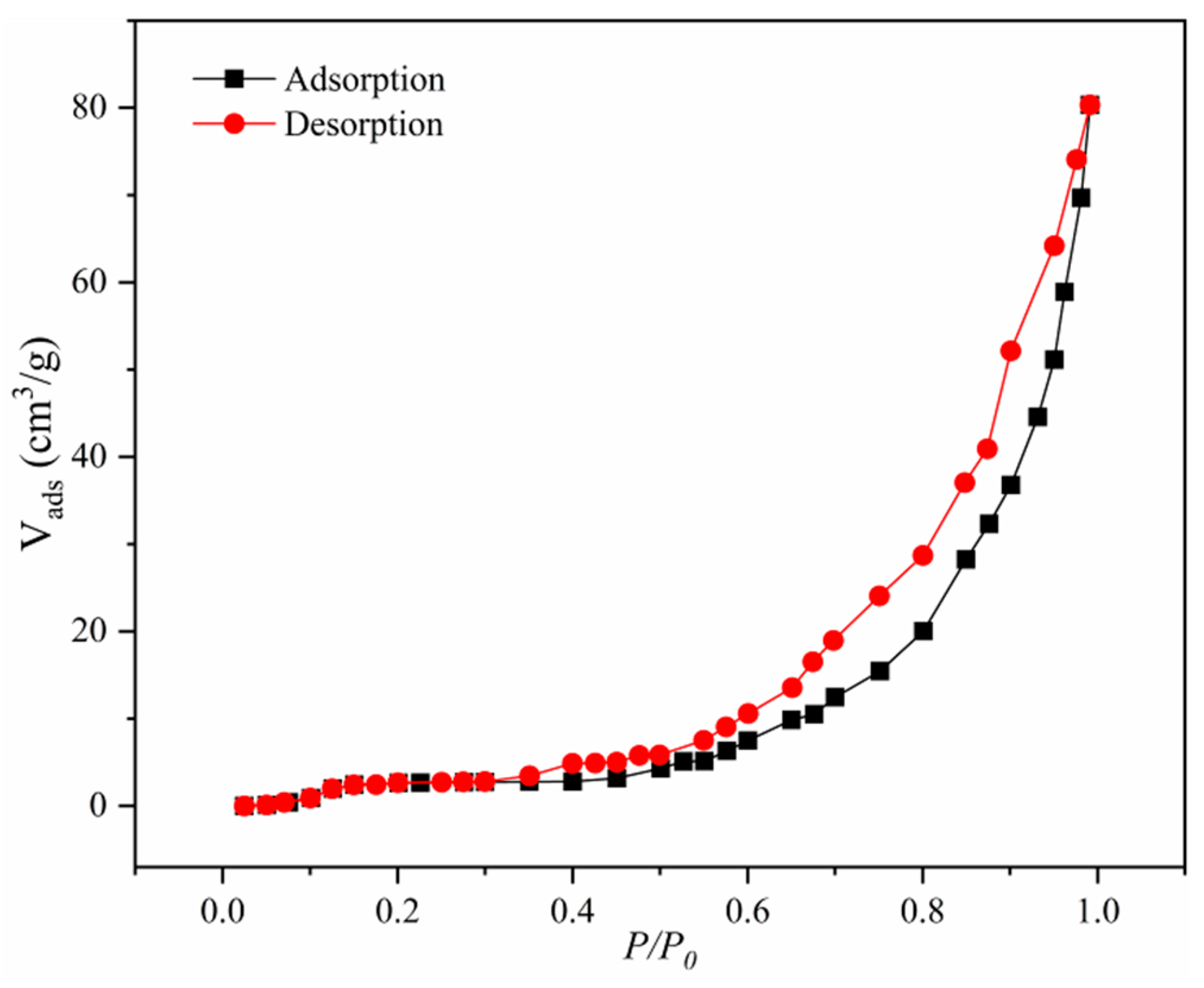
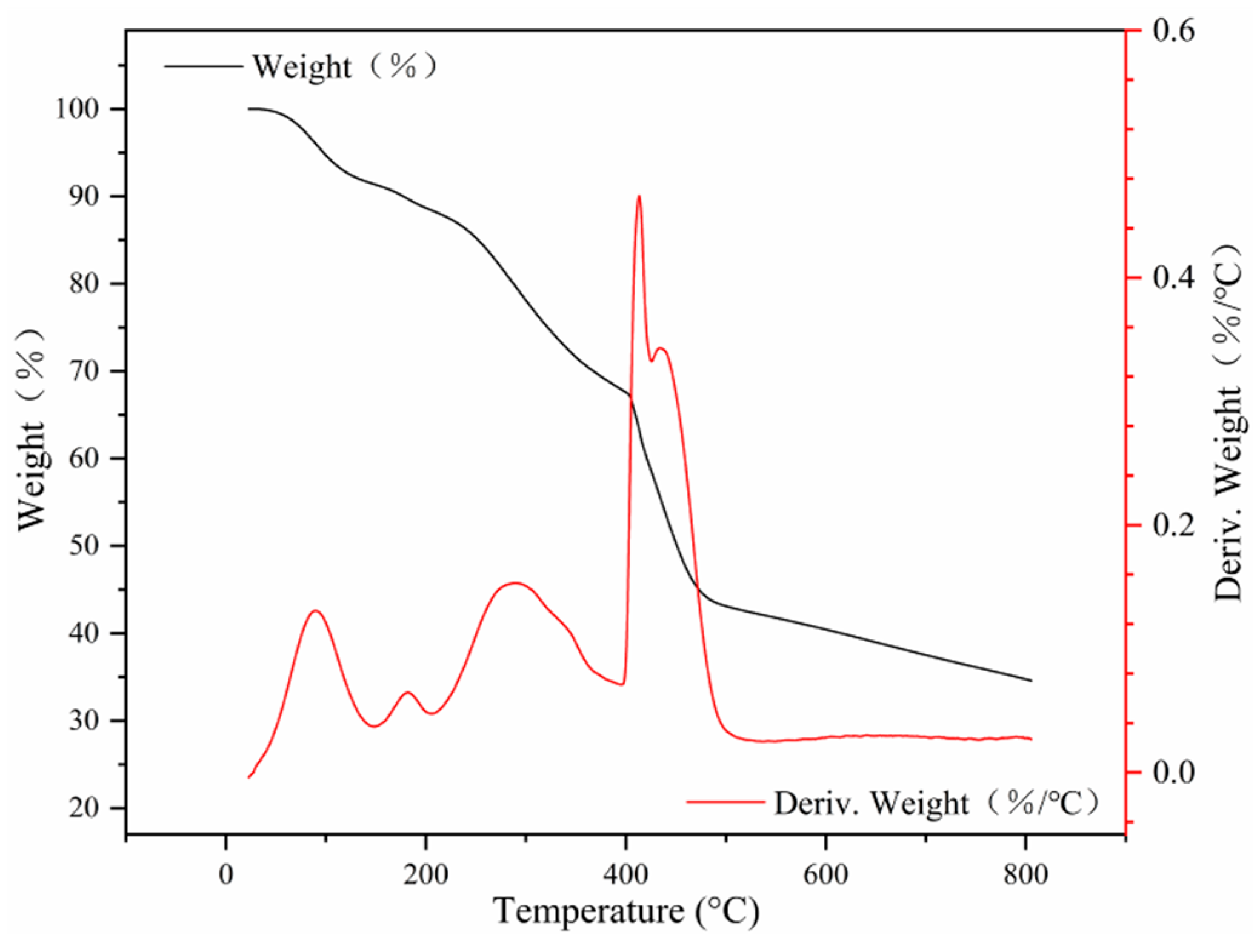
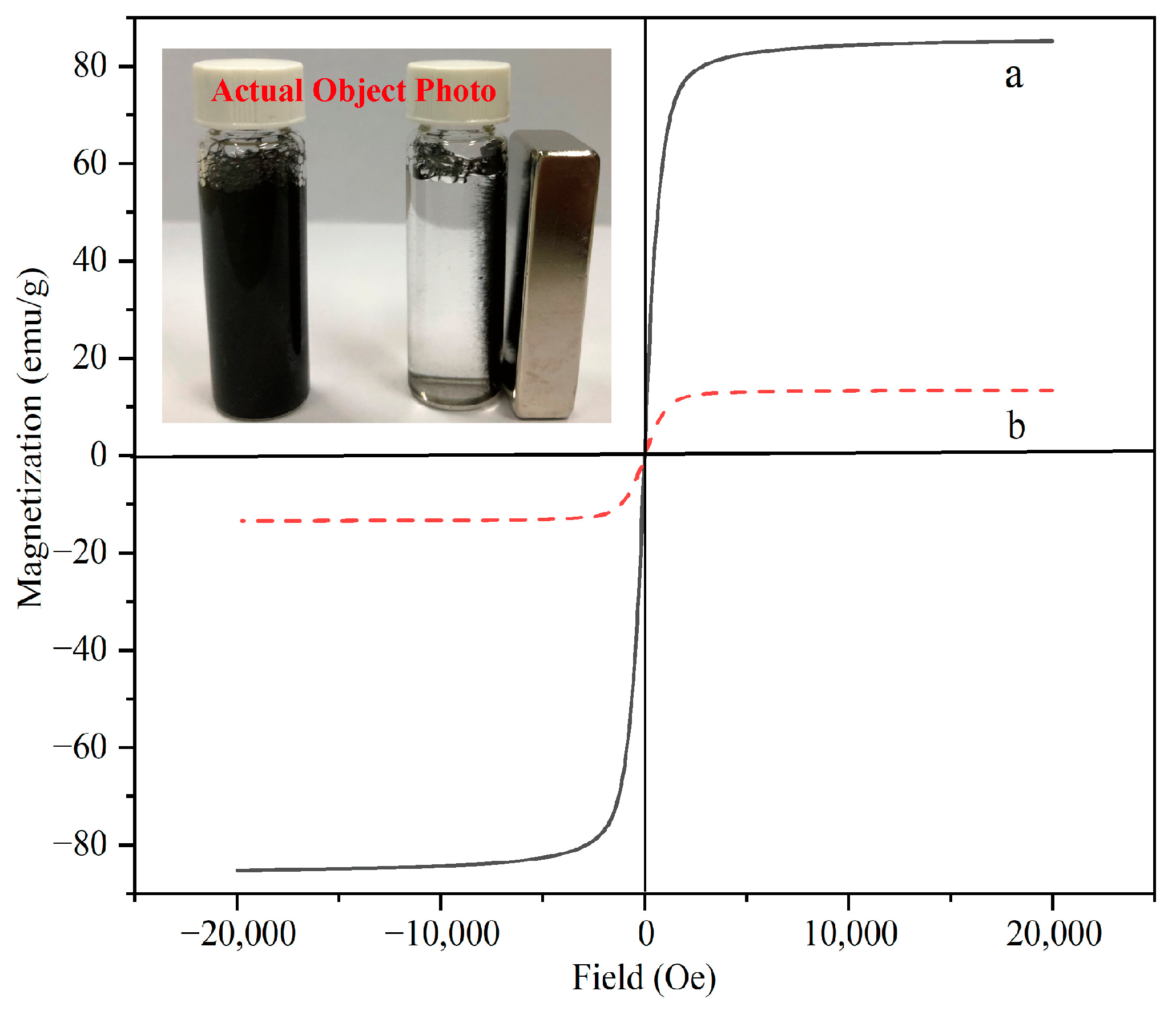
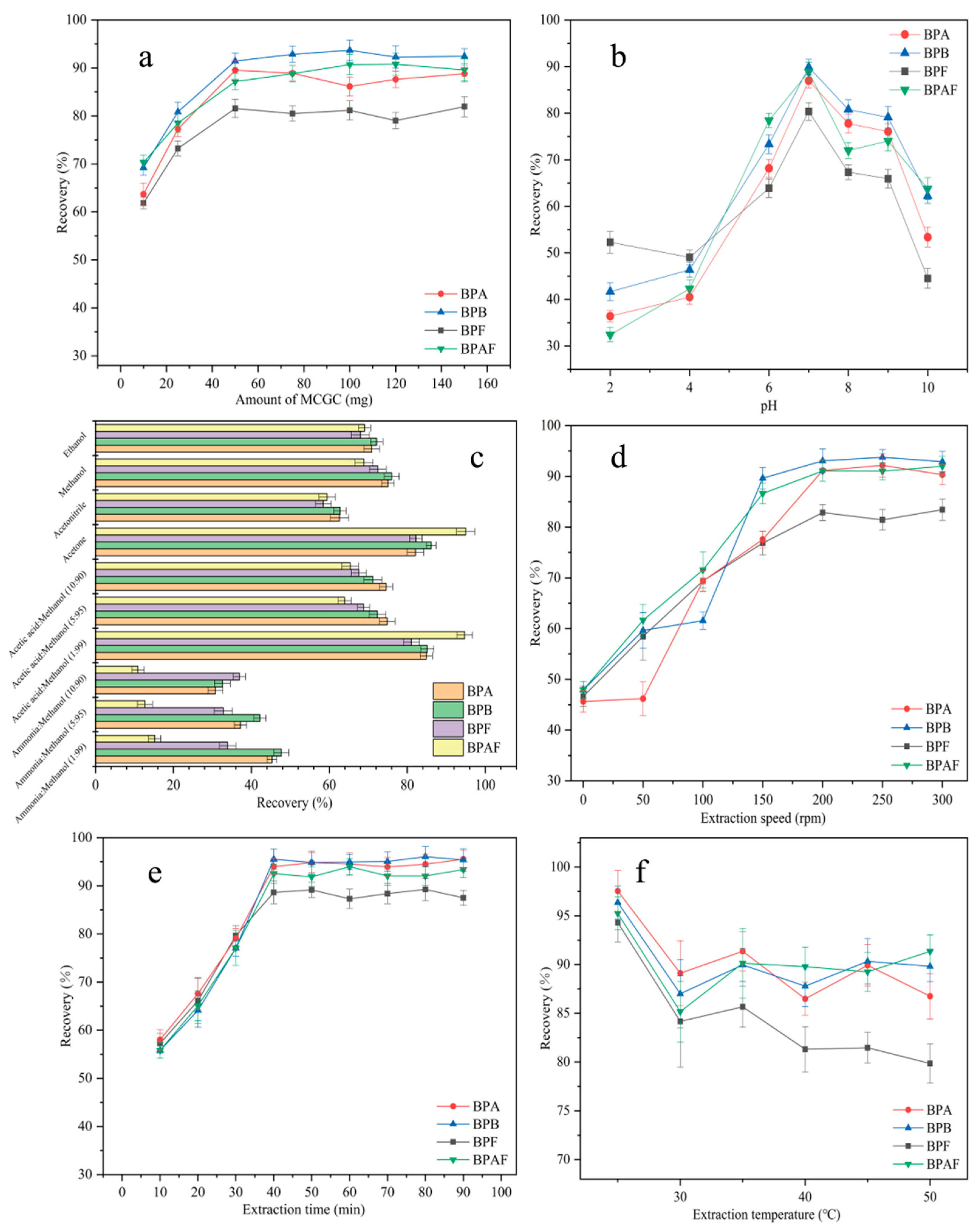

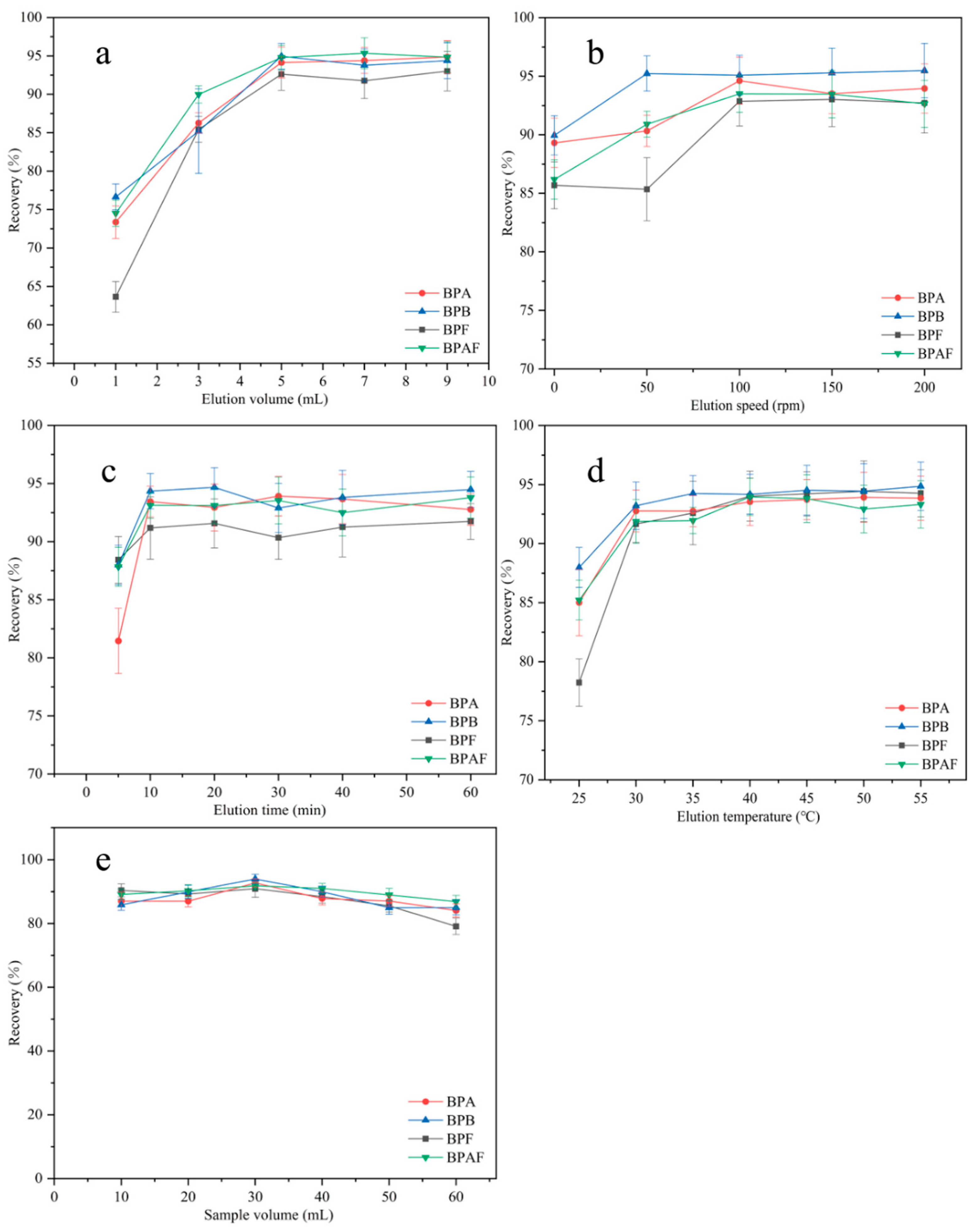
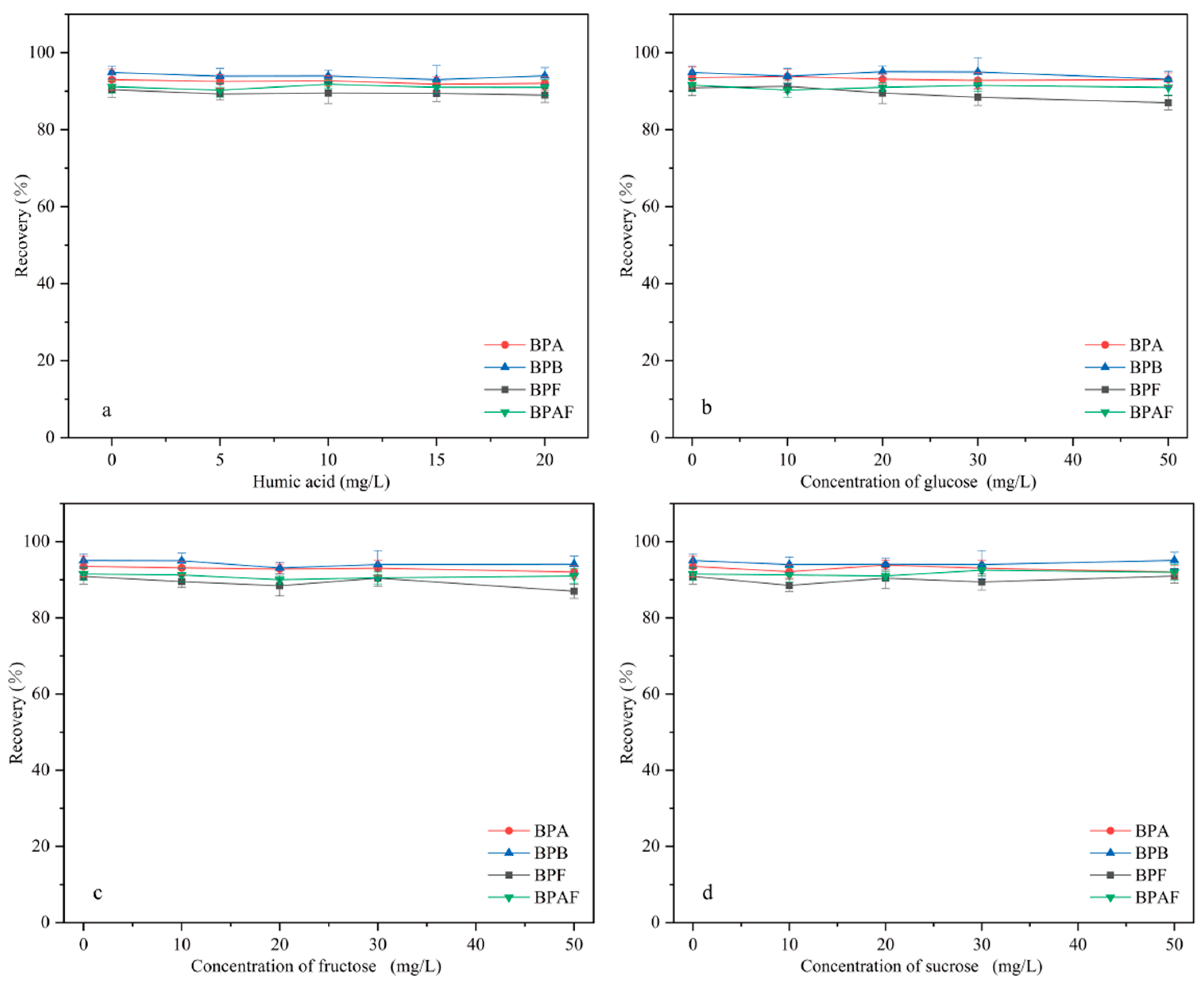
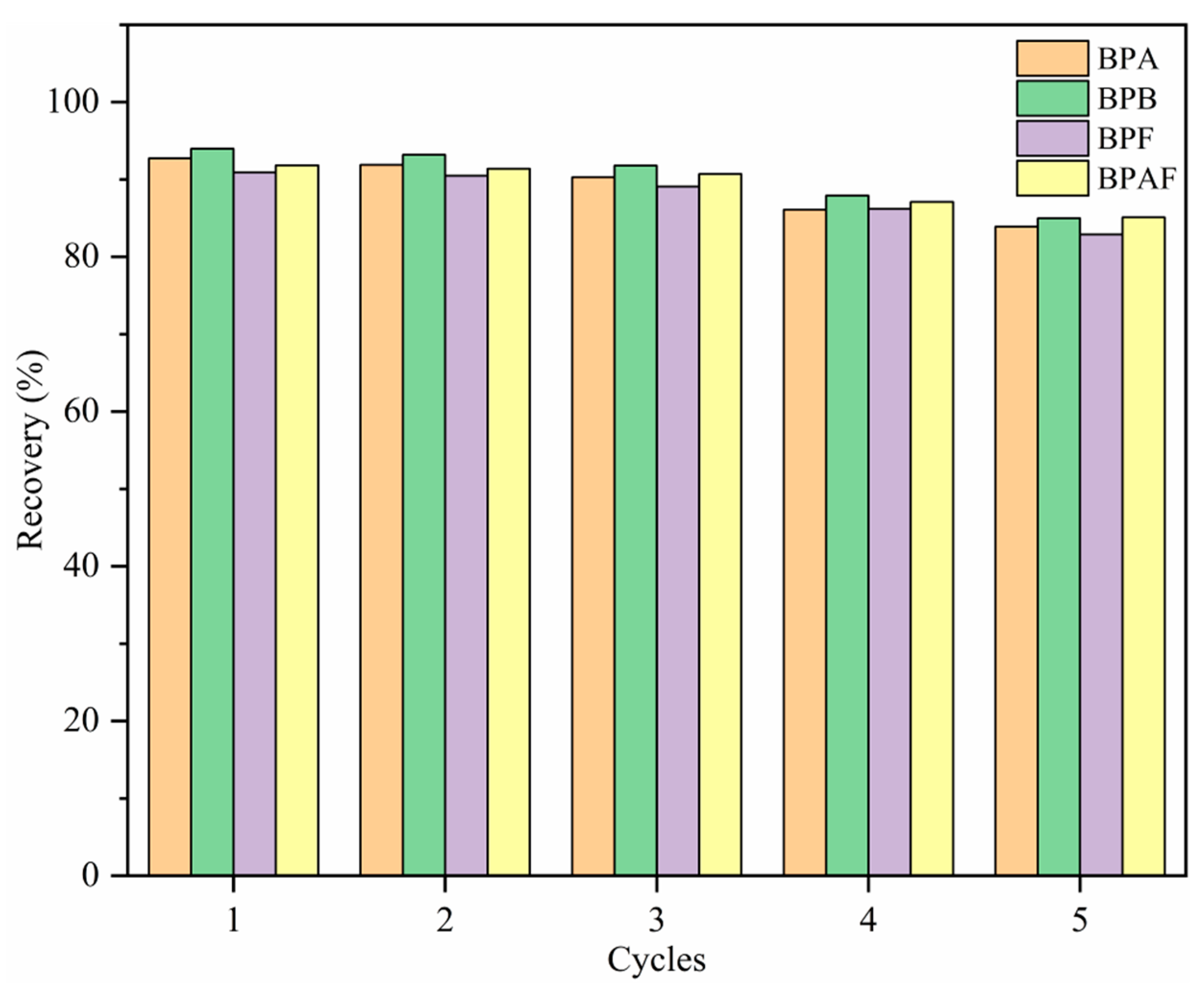
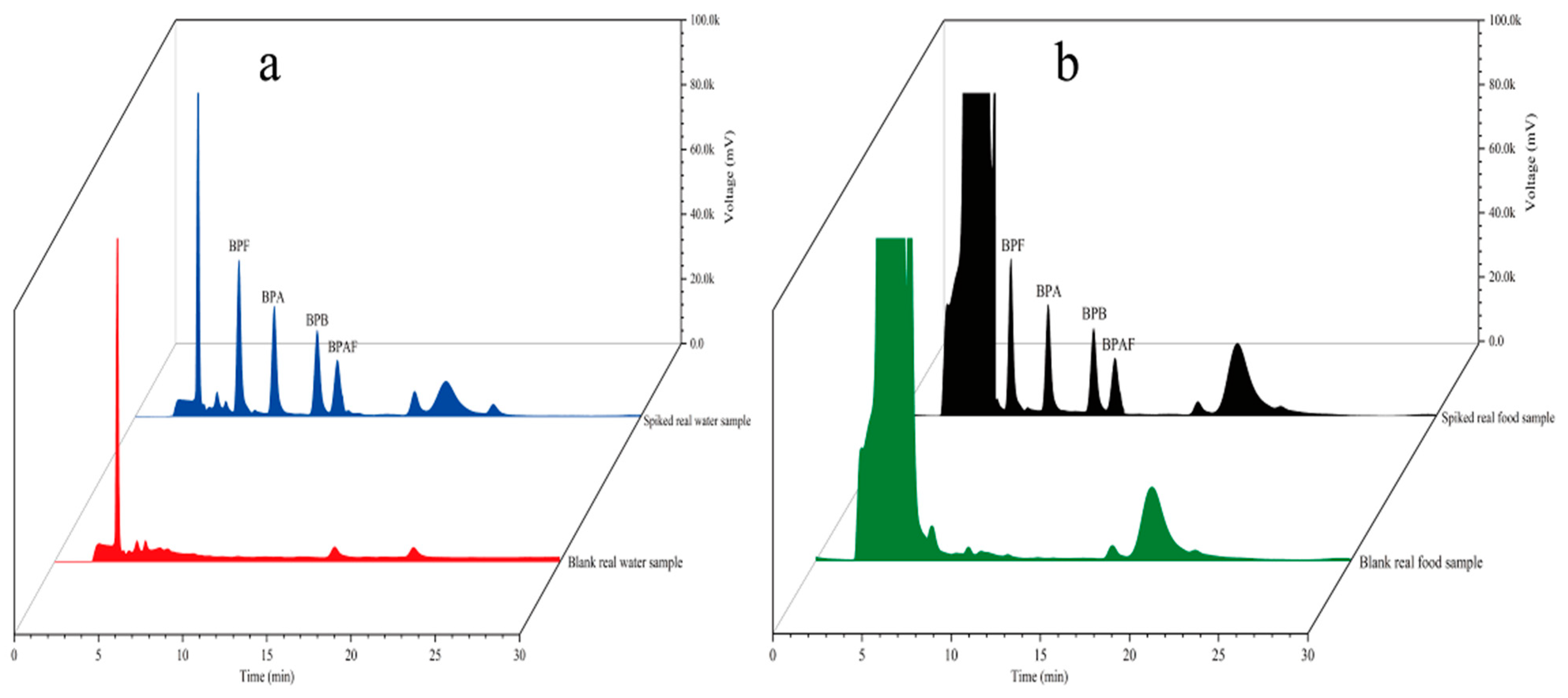

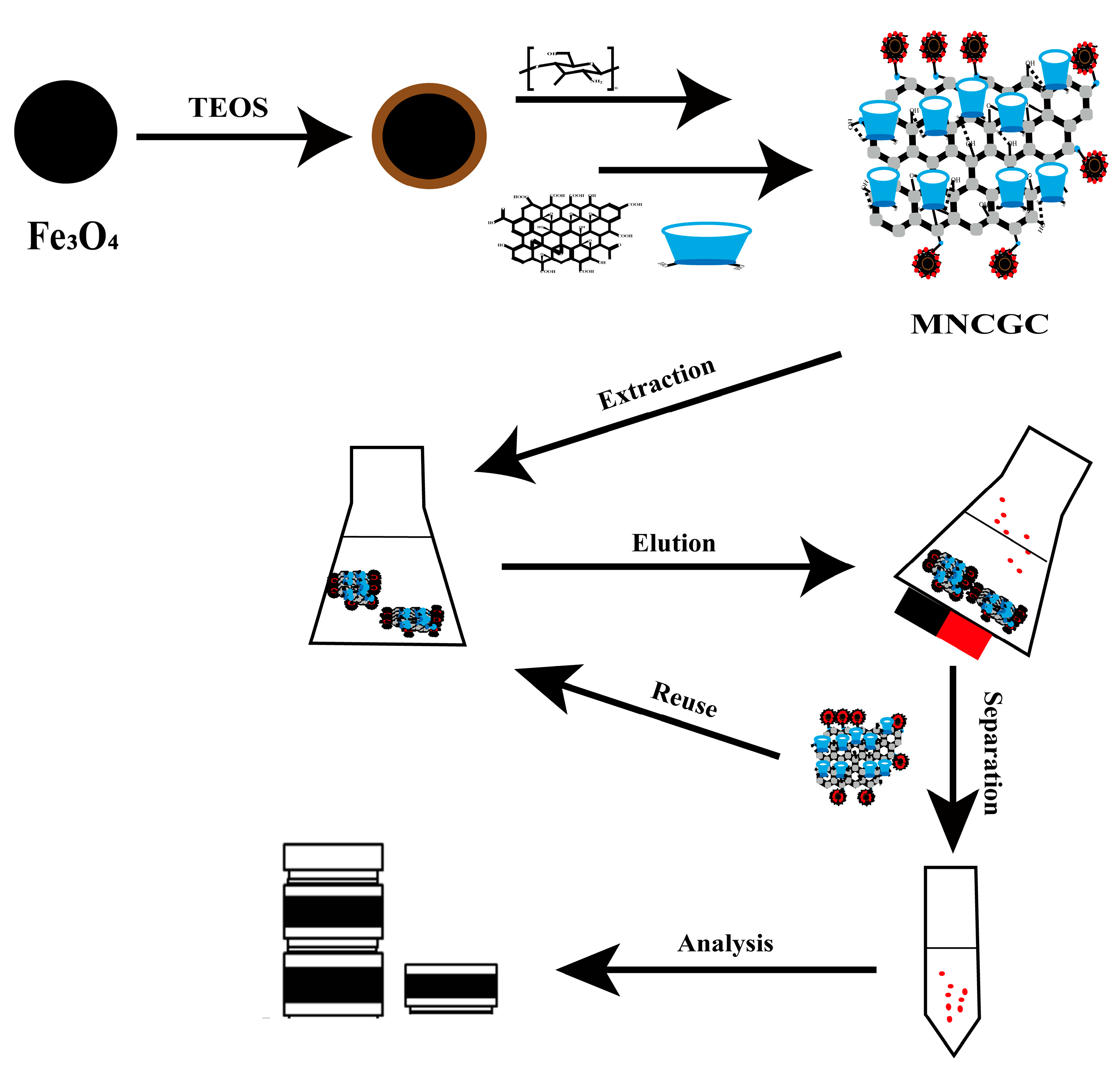
| Compound | Linearity Range (μg/L) | R | LOQ (μg/L) | LOD (μg/L) | RSD (n = 6) | RSD (n = 3) |
|---|---|---|---|---|---|---|
| BPA | 0.03–100 | 0.9999 | 0.03 | 0.01 | 2.13 | 4.34 |
| BPB | 0.05–100 | 0.9995 | 0.05 | 0.01 | 2.57 | 6.81 |
| BPF | 0.05–100 | 0.9998 | 0.05 | 0.02 | 3.41 | 5.43 |
| BPAF | 0.04–100 | 0.9989 | 0.04 | 0.01 | 2.79 | 7.17 |
| Sampling Points | Coordinate | |
|---|---|---|
| Fuhe River | S1 | 115°30′59″ E, 38°52′10″ N |
| S2 | 115°34′6″ E, 38°52′1″ N | |
| Baiyang Lake | S3 | 115°96′457″ E, 38°84′125″ N |
| S4 | 115°95′141″ E, 38°84′88″ N |
| Samples and Sampling Points | BPA (μg/L) | Recovery (%) | BPB (μg/L) | Recovery (%) | BPF (μg/L) | Recovery (%) | BPAF (μg/L) | Recovery (%) |
|---|---|---|---|---|---|---|---|---|
| Fuhe River | ||||||||
| S1 | ND a | 0.16 | 0.11 | ND | ||||
| 5 (μg/L) | 93.4 b ± 1.5 c | 95.1 ± 1.7 | 89.3 ± 2.3 | 90.2 ± 2.1 | ||||
| 10 (μg/L) | 94.1 ± 1.4 | 96.3 ± 2.1 | 89.7 ± 1.8 | 89.7 ± 1.8 | ||||
| S2 | 0.09 | 0.17 | ND | 0.17 | ||||
| 5 (μg/L) | 92.7 ± 2.1 | 96.2 ± 1.4 | 89.9 ± 1.5 | 92.5 ± 1.2 | ||||
| 10 (μg/L) | 93.3 ± 1.8 | 96.6 ± 1.6 | 90.3 ± 1.7 | 93.1 ± 1.9 | ||||
| Baiyang Lake | ||||||||
| S3 | 0.05 | 0.15 | ND | ND | ||||
| 5 (μg/L) | 93.1 ± 2.3 | 95.2 ± 1.3 | 90.5 ± 1.4 | 91.8 ± 1.4 | ||||
| 10 (μg/L) | 92.9 ± 1.2 | 96.0 ± 1.8 | 91.8 ± 2.1 | 92.4 ± 2.2 | ||||
| S4 | 0.06 | 0.14 | 0.07 | ND | ||||
| 5 (μg/L) | 93.2 ± 1.1 | 95.9 ± 1.1 | 91.3 ± 2.0 | 90.4 ± 1.7 | ||||
| 10 (μg/L) | 93.4 ± 1.6 | 94.2 ± 1.4 | 92.1 ± 3.2 | 93.1 ± 2.0 | ||||
| Food | ||||||||
| Walnut milk | 0.18 | ND | 4.92 | 3.53 | ||||
| 5 (μg/L) | 95.1 ± 2.7 | 95.1 ± 1.6 | 99.7 ± 2.7 | 100.8 ± 1.6 | ||||
| 10 (μg/L) | 96.3 ± 1.9 | 93.9 ± 2.8 | 102.3 ± 1.9 | 103.0 ± 2.4 | ||||
| Peach juice | 0.19 | 0.22 | ND | ND | ||||
| 5 (μg/L) | 94.1 ± 1.6 | 96.3 ± 2.0 | 91.4 ± 1.6 | 92.4 ± 2.2 | ||||
| 10 (μg/L) | 94.6 ± 2.3 | 96.7 ± 1.5 | 89.1 ± 2.7 | 93.1 ± 1.9 | ||||
| Orange juice | ND | 0.96 | 0.22 | ND | ||||
| 5 (μg/L) | 92.4 ± 3.1 | 97.2 ± 1.3 | 93.8 ± 1.3 | 89.9 ± 1.4 | ||||
| 10 (μg/L) | 93.3 ± 2.2 | 98.0 ± 2.2 | 95.6 ± 1.8 | 91.1 ± 1.7 |
| Method | Adsorbent | Analytes | LODs (μg/L) | Recovery (%) | Reference |
|---|---|---|---|---|---|
| MSPE–HPLC–MS a | Fe3O4@COF | Bisphenols | 0.001–0.078 | 64.8–92.8 | [25] |
| LPMD b–HPLC–UV c | Ferrofluids | Bisphenols | 0.09–0.17 | 94.5–102.1 | [34] |
| SPE d–HPLC–DAD e | HPCSs | Bisphenols | 0.05–0.53 | 89.6–111.5 | [35] |
| MSPE–HPLC–UV | Gn-MNPs | Bisphenols | 0.011–0.017 | 93.8–101.1 | [26] |
| MSPE–HPLC–FLD | MNCGC | Bisphenols | 0.01–0.02 | 90.9–94.0 | This study |
Disclaimer/Publisher’s Note: The statements, opinions and data contained in all publications are solely those of the individual author(s) and contributor(s) and not of MDPI and/or the editor(s). MDPI and/or the editor(s) disclaim responsibility for any injury to people or property resulting from any ideas, methods, instructions or products referred to in the content. |
© 2024 by the authors. Licensee MDPI, Basel, Switzerland. This article is an open access article distributed under the terms and conditions of the Creative Commons Attribution (CC BY) license (https://creativecommons.org/licenses/by/4.0/).
Share and Cite
Gong, Y.; Liu, P. A Novel Magnetic β-Cyclodextrin-Modified Graphene Oxide and Chitosan Composite as an Adsorbent for Trace Extraction of Four Bisphenol Pollutants from Environmental Water Samples and Food Samples. Molecules 2024, 29, 867. https://doi.org/10.3390/molecules29040867
Gong Y, Liu P. A Novel Magnetic β-Cyclodextrin-Modified Graphene Oxide and Chitosan Composite as an Adsorbent for Trace Extraction of Four Bisphenol Pollutants from Environmental Water Samples and Food Samples. Molecules. 2024; 29(4):867. https://doi.org/10.3390/molecules29040867
Chicago/Turabian StyleGong, Yichao, and Pengyan Liu. 2024. "A Novel Magnetic β-Cyclodextrin-Modified Graphene Oxide and Chitosan Composite as an Adsorbent for Trace Extraction of Four Bisphenol Pollutants from Environmental Water Samples and Food Samples" Molecules 29, no. 4: 867. https://doi.org/10.3390/molecules29040867







